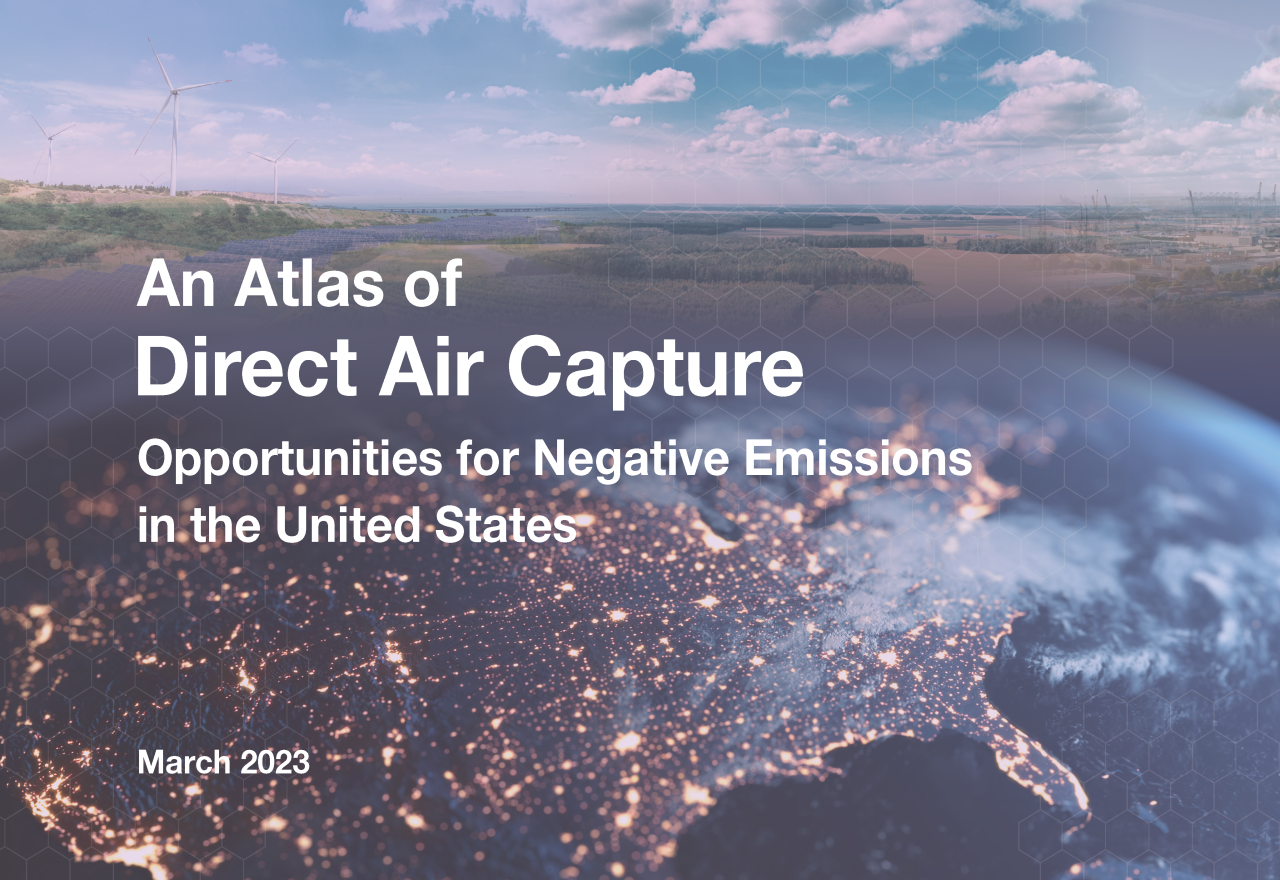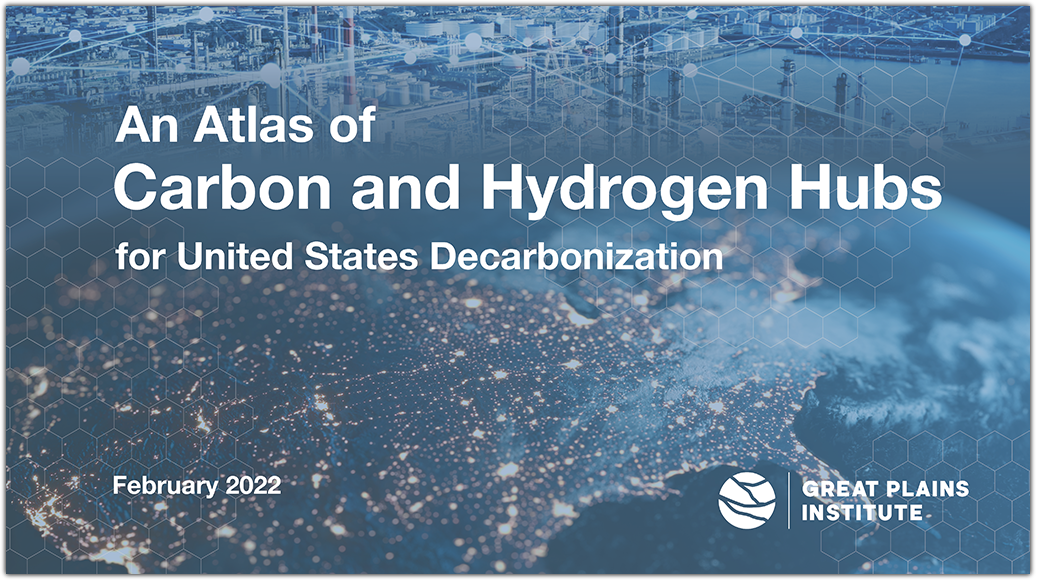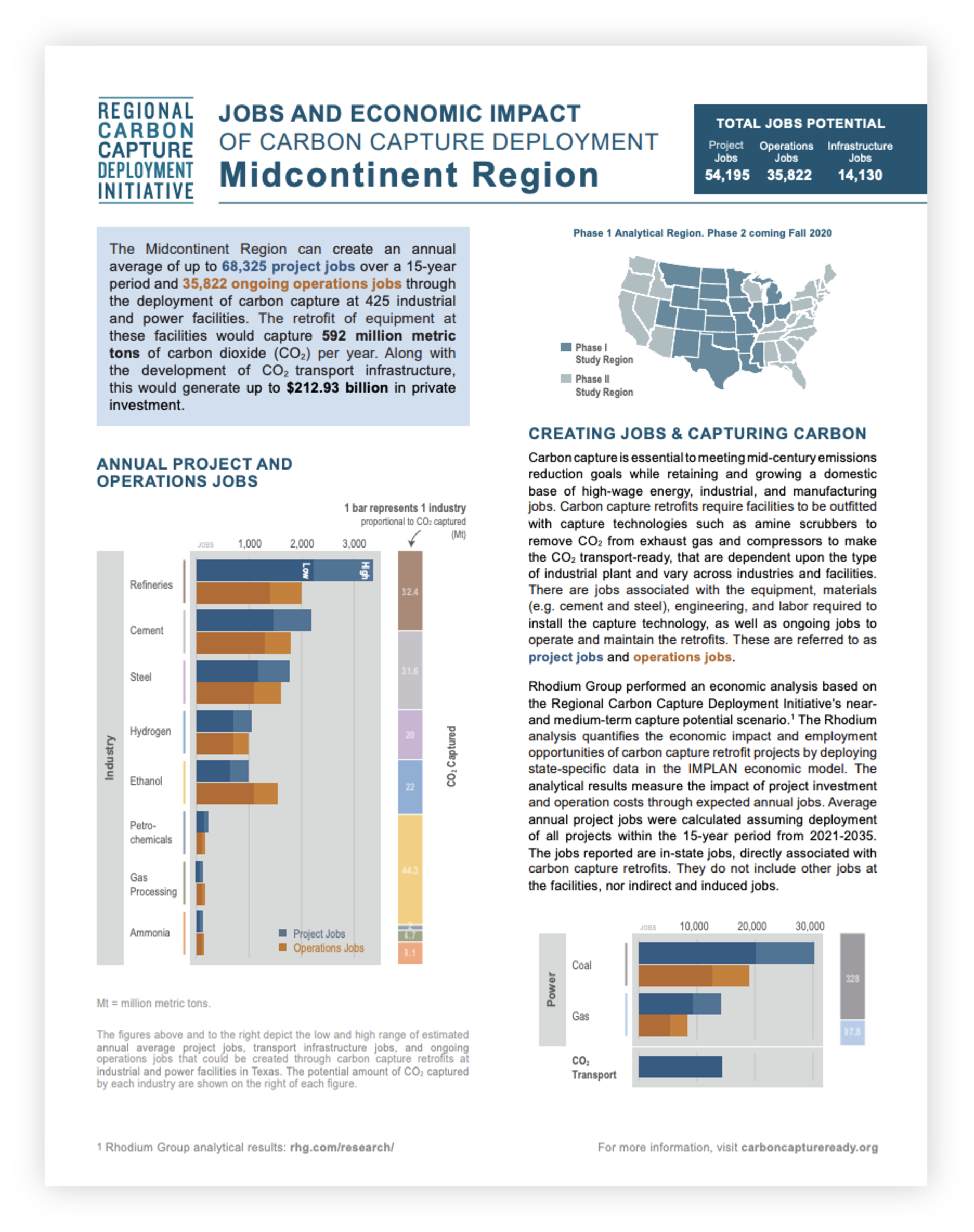Carbon Management and Decarbonization Analysis
Carbon Capture and Storage Opportunities in the Mid-Atlantic
 This report builds on the results from GPI’s Transport Infrastructure for Carbon Capture and Storage to identify regional deployment opportunities in the Mid-Atlantic region of the United States. The analysis identified capture opportunities that could be deployed in the near term as well as into the midcentury and evaluates the regional transport infrastructure and saline geologic storage needed to decarbonize the energy and industrial sectors in the Mid-Atlantic.
This report builds on the results from GPI’s Transport Infrastructure for Carbon Capture and Storage to identify regional deployment opportunities in the Mid-Atlantic region of the United States. The analysis identified capture opportunities that could be deployed in the near term as well as into the midcentury and evaluates the regional transport infrastructure and saline geologic storage needed to decarbonize the energy and industrial sectors in the Mid-Atlantic.
Carbon Capture Co-Benefits Report
Carbon Capture’s Role in Removing Pollutants and Reducing Health Impacts
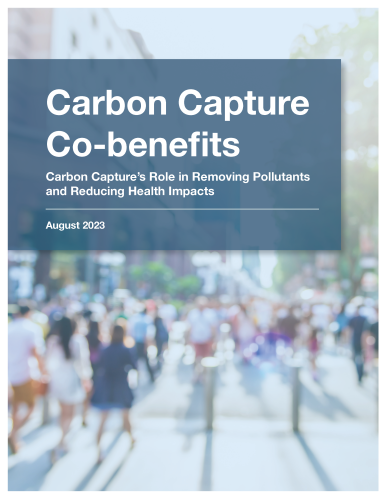 This first-of-a-kind study quantifies the health impacts of the co-benefits of reducing other air pollutants by installing carbon capture technologies at representative facilities for seven industrial and power sectors across 10 regions in the United States. Installing these technologies has the potential to result in billions of annual health benefits nationwide. The benefits included reductions in adult and infant mortality, asthma exacerbations, and overall costs of lowering risks of all health categories.
This first-of-a-kind study quantifies the health impacts of the co-benefits of reducing other air pollutants by installing carbon capture technologies at representative facilities for seven industrial and power sectors across 10 regions in the United States. Installing these technologies has the potential to result in billions of annual health benefits nationwide. The benefits included reductions in adult and infant mortality, asthma exacerbations, and overall costs of lowering risks of all health categories.
GPI’s Atlas of Direct Air Capture
GPI published an Atlas of Direct Air Capture: Opportunities for Negative Emissions in the United States in March 2023. The atlas examines key factors that impact regional suitability for developing direct air capture (DAC) technology and associated infrastructure., including transporting and storing carbon dioxide, powering a DAC facility, and technology efficiency. Through this analysis, seven regions emerged as prime locations to develop regional DAC hubs, each with a unique set of advantages: California, Rockies & Northern Plains, Permian, Midcontinent, Gulf, Midwest, and Mid-Atlantic & Great Lakes.
GPI’s Carbon and Hydrogen Hubs Atlas
GPI published an Atlas of Carbon and Hydrogen Hubs in February, 2022, based on analysis of United States industrial activity, emissions, and fuel combustion. This atlas considers geologic storage potential, current hydrogen production, industrial concentration, and many other factors that provide opportunities for siting carbon dioxide removal, carbon capture retrofit, and new zero-carbon hydrogen production.
Or, click below to view a hubs fact sheet for each region:
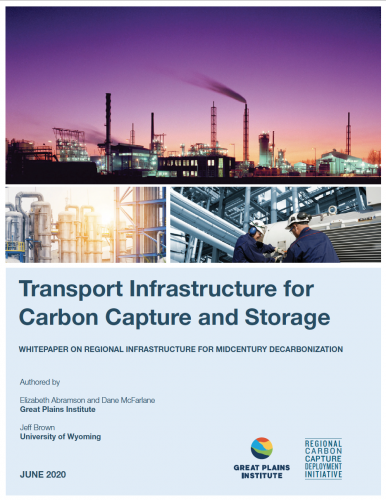
Carbon Capture and Storage Infrastructure for Midcentury Decarbonization
This report provides data sources, details the analytical methodology, and identifies potential capture facilities throughout the Western and Midwestern regions, as well as primary modeling scenarios and conclusions on regional CO2 capture, transport, and storage opportunities.
Download the report below.
Jobs and Economic Growth Fact Sheets
The Regional Deployment Initiative has released a series of state fact sheets on potential jobs creation and economic impact of carbon capture deployment, based on collaborative analysis by Rhodium Group. The Rhodium analysis quantifies the economic impact and employment opportunities of carbon capture retrofit projects by deploying state-specific data in the IMPLAN economic model.
Download each state fact sheet below:
Near and Medium Term Deployment
Los Alamos National Laboratory’s SimCCS model was used to identify optimal regional scale transport networks that deliver CO2 from near- and medium-term opportunities for capture at industrial and power facilities to likely geologic storage opportunities in deep saline formations and existing EOR operations. These maps are meant to provide a birds-eye view of what an evolving regional CO2 transport network could look like when optimizing for both cost feasibility and environmental benefit.
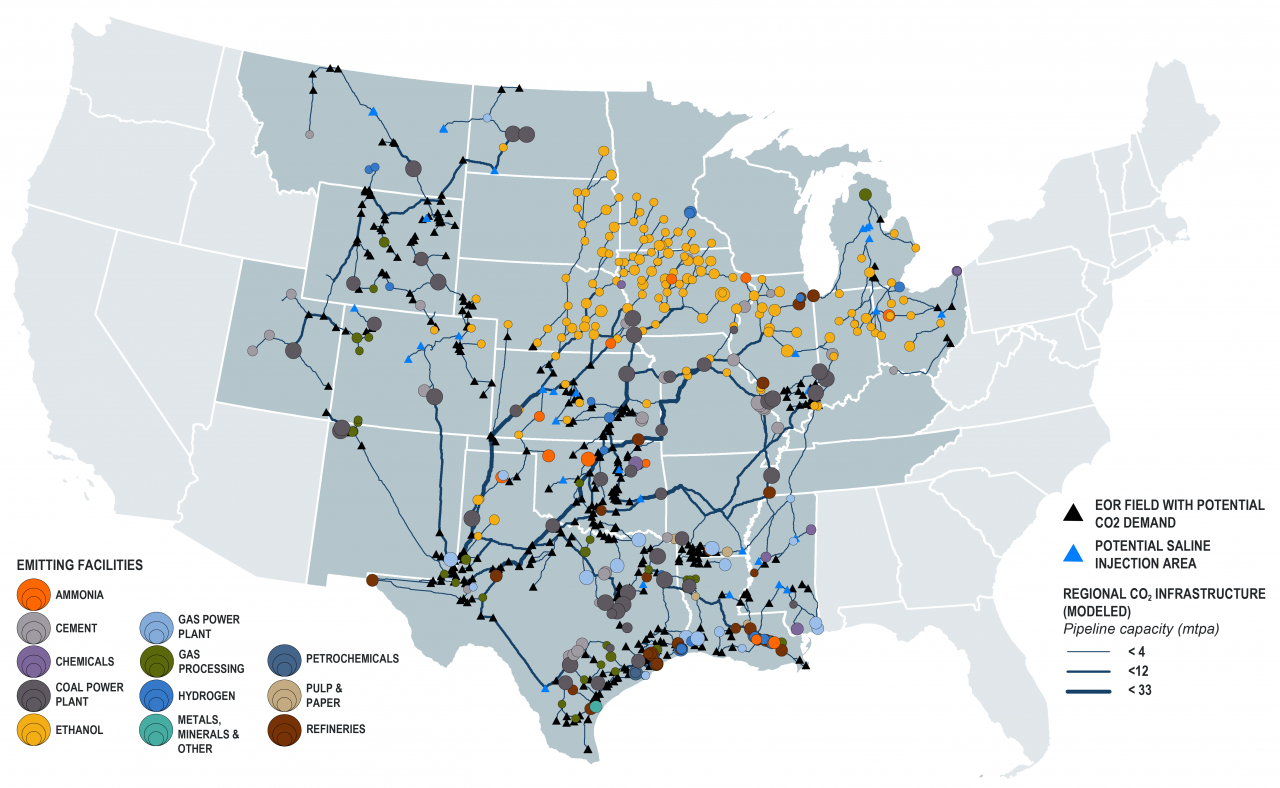
Long Term Economy-Wide Deployment
An expanded regional-scale network scenario was modeled to include saline storage for an expanded set of 45Q-eligible facilities in addition to the near- and medium-term facilities. This resulted in a regional CO2 transport network similar to the initial scenario but with expanded storage in saline formations in the eastern parts of the Midwest, Gulf Coast states, and various locations throughout the Rockies.
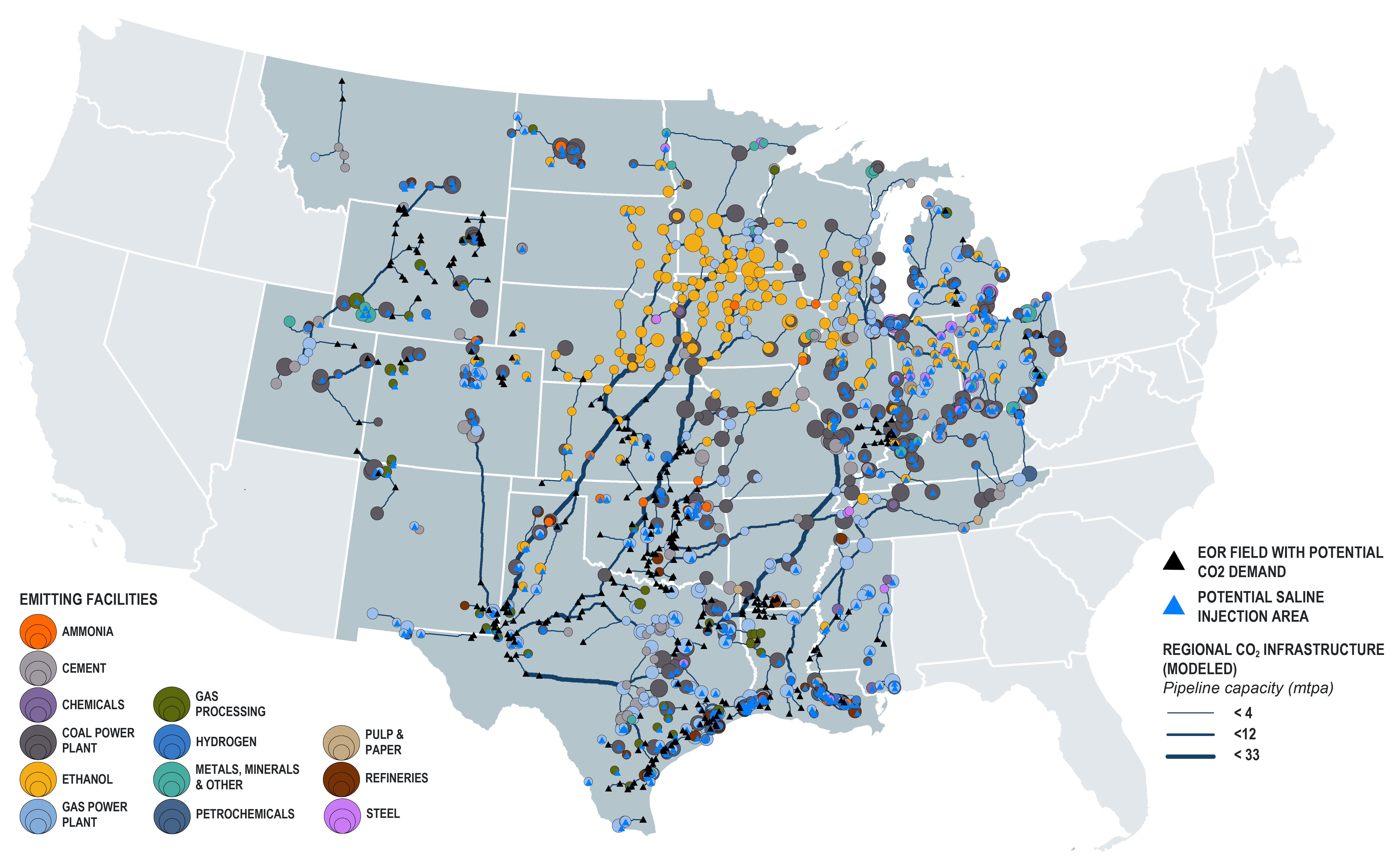
Regional Analysis
The Regional Carbon Capture Deployment Initiative has conducted regional-scale modeling on potential CO2 sources, storage opportunities, and transport corridors since 2017.
The primary goal of this analysis is to identify the fleet of industrial and power facilities where carbon capture has been made economically feasible by the 45Q tax credit for carbon capture, then link these sources to potential storage and utilization sites in deep geologic saline formations or hydrocarbon basins. Sophisticated models are also used to envision and plan regional-scale CO2 transport infrastructure to most efficiently link these sources and storage locations.
Data sources and inputs into the Regional Carbon Capture & Storage Analysis
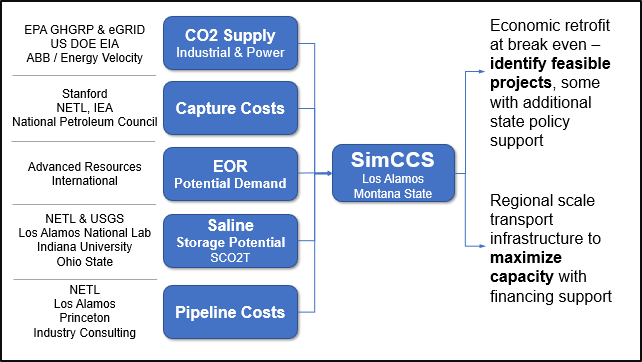
Scope
This analysis is focused on carbon capture and storage opportunities in two regions: the West and the Midwest. States in the south central region of the US, such as Texas, Oklahoma, and Louisiana, are also included as primary destination markets for CO2 storage and use, as well as sources of CO2 from a diverse array of industrial and power facilities.
CO2 Sources
Industrial facilities with large quantities of emissions, consistent and continuous operating periods, and production processes with identifiable application points for capture equipment retrofit (among many other factors) are needed to achieve economically efficient carbon capture. The purity or concentration of CO2 emissions being emitted at the facility is a primary factor in estimating capture costs.
Industries with high purity CO2 emissions, such as ethanol refining, natural gas processing, and ammonia production, provide significant potential for low cost carbon capture that requires only compression and dehydration of emissions. The use of amine separation equipment to capture lower-concentrated CO2 opens up more opportunities in industries such as cement production, oil refining, steel, and hydrogen. In some cases, carbon capture represents one of the only significant methods for industrial processes to decarbonize. Finally, power facilities that use coal and natural gas as an energy source are also included in this analysis as potential sources of CO2 with capture retrofit.
CO2 Storage
A number of studies coordinated by the US Department of Energy and the US Geological Survey, and conducted by research organizations in many states, have identified ample CO2 storage opportunities in deep geologic formations throughout the US. The primary focus of these studies is to identify safe, secure, and long-term storage locations. Deep saline formations across the continent have the potential to provide permanent storage of quantities equivalent to hundreds of years of US CO<2 emissions. There also currently exists economic demand for CO2 for use and storage in enhanced oil recovery operations.
CO2 Transport
CO2 must be transported from capture facilities to storage locations, often by tanker trucks or pipeline. Coordinated, long-term planning of CO2 transport infrastructure will provide the most economically efficient method for transporting the quantities of CO2 that the US will need to store in order to meet international emissions and temperature goals by mid-century. Unlike other types of transport infrastructure, CO2 pipelines present virtually no risk to environmental or human health, as the materials being transported are not flammable or toxic, and are continuously being released by facilities throughout the country.
Analysts with the Regional Carbon Capture Deployment Initiative collaborate with Los Alamos National Laboratory, using the SimCCS model to optimize CO2 transport infrastructure and plan a number of potential scenarios for regional capture and storage.
Collaborators and Partners
The Regional Carbon Capture Deployment Initiative analysis is made possible through close collaborations between a number of institutions, organizations, and entities, such as: Great Plains Institute, Los Alamos National Laboratory, Stanford University, Indiana Geological and Water Survey, Advanced Resources International, the National Energy Technology Laboratory, US Environmental Protection Agency, US Dept of Energy, and Ohio State University. A full list of contributors and data sources will be provided in the forthcoming analytical report.
Contact
For more information or to ask questions about the Regional Initiative’s analysis, methodology, and sources, feel free to contact:
Emma Thomley, Great Plains Institute


